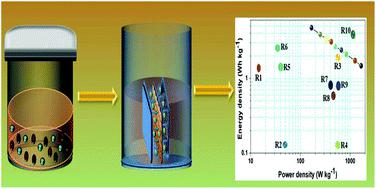当前位置:
X-MOL 学术
›
Inorg. Chem. Front.
›
论文详情
Our official English website, www.x-mol.net, welcomes your feedback! (Note: you will need to create a separate account there.)
Hydrothermally synthesized chalcopyrite platelets as an electrode material for symmetric supercapacitors
Inorganic Chemistry Frontiers ( IF 7 ) Pub Date : 2019-12-23 , DOI: 10.1039/c9qi01335k Surjit Sahoo 1, 2, 3, 4, 5 , Parthiban Pazhamalai 1, 2, 3, 4, 5 , Vimal Kumar Mariappan 1, 2, 3, 4, 5 , Ganesh Kumar Veerasubramani 6, 7, 8, 9 , Nam-Jin Kim 4, 10, 11, 12 , Sang-Jae Kim 1, 2, 3, 4, 5
Inorganic Chemistry Frontiers ( IF 7 ) Pub Date : 2019-12-23 , DOI: 10.1039/c9qi01335k Surjit Sahoo 1, 2, 3, 4, 5 , Parthiban Pazhamalai 1, 2, 3, 4, 5 , Vimal Kumar Mariappan 1, 2, 3, 4, 5 , Ganesh Kumar Veerasubramani 6, 7, 8, 9 , Nam-Jin Kim 4, 10, 11, 12 , Sang-Jae Kim 1, 2, 3, 4, 5
Affiliation

|
In this work, a novel chalcopyrite (CuFeS2) platelet like open-pored micro-flower structured electrode material was synthesized via a one-step hydrothermal method and its electrochemical performance as an electrode material for supercapacitors were investigated. First and foremost, the structural, morphological, vibrational, and chemical compositional characteristics of the as prepared CuFeS2 were investigated by X-ray diffraction (XRD), field emission scanning electron microscopy (FE-SEM) with elemental mapping, laser Raman spectroscopy, and X-ray photoelectron spectroscopy (XPS), respectively. Subsequently, the electrochemical properties of the CuFeS2 electrode were explored using cyclic voltammetry (CV), galvanostatic charge–discharge (CD), and electrochemical impedance spectroscopy (EIS) studies in 1 M LiOH electrolyte. Cyclic voltammetry and charge–discharge analysis reveal the pseudocapacitive nature of the CuFeS2 electrode by obtaining a maximum specific capacity of about 26.46 mA h g−1 (specific capacitance of about ∼95.28 F g−1) at a scan rate of 5 mV s−1 with a cycling stability retention of 94.38% even after 2000 cycles at a discharge current rate of 5 mA. Furthermore, in view of practical application a symmetric supercapacitor device was fabricated using the CuFeS2 electrode which delivered a maximum specific capacitance of about 34.18 F g−1 at a current rate of 1 mA and a maximum energy density of about 4.74 W h kg−1 with excellent cycling stability. The acquired results confirmed that the CuFeS2 electrode could be a prospective and electrochemically active candidate for next generation supercapacitors.
中文翻译:

水热合成黄铜矿薄片作为对称超级电容器的电极材料
通过一步水热法合成了一种新型的类似开孔微花结构的黄铜矿(CuFeS 2)片状电极材料,并研究了其作为超级电容器电极材料的电化学性能。首先,通过X射线衍射(XRD),场发射扫描电子显微镜(FE-SEM)和元素图谱,激光拉曼光谱研究了所制备的CuFeS 2的结构,形态,振动和化学组成特征,和X射线光电子能谱(XPS)。随后,CuFeS 2的电化学性质在1 M LiOH电解液中,使用循环伏安法(CV),恒电流充放电(CD)和电化学阻抗谱(EIS)研究了电极。循环伏安法和充放电分析揭示CuFeS的赝电容性质2通过获得约26.46毫安Hg的最大比容量电极-1(约~95.28 F G比电容-1以5毫伏s的扫描速率)- 1在5mA的放电电流率下即使经过2000次循环也具有94.38%的循环稳定性保持率。此外,鉴于实际应用,使用CuFeS 2电极制造了对称超级电容器器件,该电极提供了约34.18 F g的最大比电容。-1在1 mA的电流速率和约4.74 W h kg -1的最大能量密度下具有出色的循环稳定性。获得的结果证实,CuFeS 2电极可能是下一代超级电容器的前瞻性和电化学活性候选物。
更新日期:2019-12-23
中文翻译:

水热合成黄铜矿薄片作为对称超级电容器的电极材料
通过一步水热法合成了一种新型的类似开孔微花结构的黄铜矿(CuFeS 2)片状电极材料,并研究了其作为超级电容器电极材料的电化学性能。首先,通过X射线衍射(XRD),场发射扫描电子显微镜(FE-SEM)和元素图谱,激光拉曼光谱研究了所制备的CuFeS 2的结构,形态,振动和化学组成特征,和X射线光电子能谱(XPS)。随后,CuFeS 2的电化学性质在1 M LiOH电解液中,使用循环伏安法(CV),恒电流充放电(CD)和电化学阻抗谱(EIS)研究了电极。循环伏安法和充放电分析揭示CuFeS的赝电容性质2通过获得约26.46毫安Hg的最大比容量电极-1(约~95.28 F G比电容-1以5毫伏s的扫描速率)- 1在5mA的放电电流率下即使经过2000次循环也具有94.38%的循环稳定性保持率。此外,鉴于实际应用,使用CuFeS 2电极制造了对称超级电容器器件,该电极提供了约34.18 F g的最大比电容。-1在1 mA的电流速率和约4.74 W h kg -1的最大能量密度下具有出色的循环稳定性。获得的结果证实,CuFeS 2电极可能是下一代超级电容器的前瞻性和电化学活性候选物。


























 京公网安备 11010802027423号
京公网安备 11010802027423号